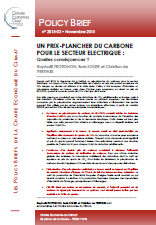
Economic instruments and the 2015 Paris Climate Conference: the catalyst of carbon pricing
By Christian de Perthuis, Pierre-André Jouvet, Raphaël Trotignon, Boris Solier, Bénédicte Meurisse, Simon Quemin
As shown by the collective action for the protection of the ozone layer under the Montreal Protocol, the success of a multilateral agreement rests on three pillars: strong political commitment, an independent and rigorous monitoring system, and economic instruments that transmit the right incentives. For it to be a success, the 2015 Paris climate conference will need to make progress on each of these three pillars. The Climate Economics Chair has focussed its research efforts on the pillar of economic instruments.
- The Fifth Assessment Report of the IPCC states unequivocally that from 2020 all major emitters of greenhouse gas emissions must participate in the global effort to reduce emissions and limit average warming to no more than 2°C.
- In order to drastically curb emission trajectories, global carbon pricing should be rapidly introduced, so as to put pressure on governments to act cooperatively and to encourage economic actors to reduce emissions at the lowest cost.
- To encourage governments to reach a global agreement, a bonus-malus carbon pricing system, calculated on the basis of average emissions per capita, could be introduced at a rate of $7-9 per tonne of CO2 equivalent from 2020.
- The most realistic way of introducing an international carbon price into the global economy is to lay the foundation, between 2015 and 2020, of a transcontinental carbon market, based on prototypes developed in Europe, China and the United States.
- The introduction of double carbon pricing would be subject to the principle of “common but differentiated responsibilities”, aimed at reconciling joint action on climate change and the priority of access to development.
